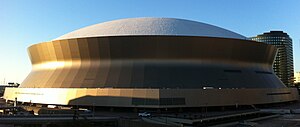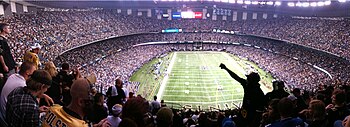Mercedes-Benz Superdome
| Mercedes-Benz Superdome | |
|---|---|
| The Superdome, The Dome | |
 | |
| Former names | Louisiana Superdome (1975–2011) |
| Location | 1500 Sugar Bowl Drive New Orleans, Louisiana 70112 |
| Coordinates | 29°57′3″N 90°4′52″W / 29.95083°N 90.08111°WCoordinates: 29°57′3″N 90°4′52″W / 29.95083°N 90.08111°W |
| Broke ground | August 11, 1971 |
| Opened | August 3, 1975 |
| Owner | Louisiana Stadium/Expo District, Glenn Menard (Manager) |
| Operator | SMG |
| Surface | Monsanto "Mardi Grass" turf (1975–2003)[1] FieldTurf (2003–2006) Sportexe Momentum Turf (2006–2009) UBU-Intensity Series-S5-M Synthetic Turf (2010–present) Concrete for multipurpose events |
| Construction cost | $134 million (Initial) ($579 million in 2013 dollars[2]) $193 million (2005–06 repairs) Renovations: ($223 million in 2013 dollars[2]) |
| Architect | Curtis and Davis Associated[3] Edward B. Silverstein & Associates[3] Nolan, Norman & Nolan[3] |
| Structural engineer | Sverdrup & Parcel[3] Thornton Tomasetti (2006 repairs) |
| General contractor | Huber, Hunt, & Nichols/Blount Joint Venture[4] |
| Capacity | American football: 73,208 (expandable to 76,468)[5] Basketball: 55,675 Baseball: 63,525 |
| Tenants | |
| New Orleans Saints (NFL) (1975–present) Sugar Bowl (NCAA) (1975–present) Tulane Green Wave (NCAA) (1975–present) New Orleans Jazz (NBA) (1975–1979) New Orleans Pelicans (American Association) (1977) New Orleans Breakers (USFL) (1984) New Orleans Night (AFL) (1991–1992) New Orleans Bowl (NCAA) (2001–present) | |
The Mercedes-Benz Superdome, previously known as the Louisiana Superdome and colloquially known as the Superdome, is a sports and exhibition arena located in the Central Business District of New Orleans, Louisiana, USA. Plans were drawn up in 1967 by the New Orleans modernist architectural firm of Curtis and Davis. Its steel frame covers a 13-acre (5.3 ha) expanse. Its 273-foot (83 m) dome is made of a Lamella multi-ringed frame and has a diameter of 680 feet (210 m), making it the largest fixed domed structure in the world.
It is home to the NFL's New Orleans Saints, the NCAA's Division I-A Tulane Green Wave football team (the largest football stadium in Conference USA), the State Farm Bayou Classic, the R+L Carriers New Orleans Bowl, the Allstate Sugar Bowl and, every fourth year, the BCS National Championship Game. Because of the size and location in one of the major tourist destinations in the United States, the Superdome routinely makes the "short list" of candidates being considered for major sporting events, such as the Super Bowl and the Final Four.
In 2005, the Superdome gained international attention of a different type when it housed thousands of people seeking shelter from Hurricane Katrina. The building suffered extensive damage as a result of the storm, and was closed for many months afterward.
On October 3, 2011, it was announced that Mercedes-Benz purchased naming rights to the stadium. The new name took effect on October 23, 2011.[6] It is the third stadium that has naming rights from Mercedes-Benz (and first in the United States), after the Mercedes-Benz Arena, the stadium of Bundesliga club VfB Stuttgart, in Stuttgart, Germany and the Mercedes-Benz Arena in Shanghai, China.
Description
The Superdome is located on 52 acres (21 ha) of land, including the former Girod Street Cemetery. The dome has an interior space of 125,000,000 cubic feet (3,500,000 m3), a height of 253 feet (77.1 m), a dome diameter of 680 feet (207.3 m), and a total floor area of 269,000 square feet (24,991 m2).
[edit] Capacity
The Superdome has a listed football seating capacity of 76,468 (expanded) or 73,208 (not expanded), a maximum basketball seating capacity of 73,432, and a maximum baseball capacity of 63,525; however, published attendance figures from events such as the Sugar Bowl football game have exceeded 79,000. The basketball capacity does not reflect the NCAA's new policy on arranging the basketball court on the 50-yard line on the football field, per 2009 NCAA policy.[7] In 2011, 3,500 seats were added, increasing the Superdome's capacity to 76,468.
The chronology of the capacity for football is as follows:
- 74,452 (1975–1978)[8]
- 71,330 (1979–1984)[9]
- 71,647 (1985–1986)[10]
- 69,723 (1987–1990)[11]
- 69,065 (1991–1994)[12]
- 70,852 (1995)[13]
- 64,992 (1996)[14]
- 69,420 (1997)[15]
- 69,028 (1998)[16]
- 70,054 (1999)[17]
- 64,900 (2000)[18]
- 70,020 (2001)[19]
- 68,500 (2002–2003)[20]
- 64,900 (2004–2005)[21]
- 68,354 (2006)[22]
- 72,968 (2007–2010)[23]
- 73,208 (expandable to 76,468) (2011–present)
[edit] American Football

The Superdome's primary tenant is the NFL's New Orleans Saints. The team regularly draws capacity crowds.[25]
The NFL has hosted six Super Bowls at the Superdome, with a seventh scheduled for 2013.
In college football, Tulane University plays all of their home games at the stadium, although the school is planning to build a smaller on-campus stadium and move there in 2014.[26] The BCS National Championship Game has been played at the Superdome four times. Two other bowl games are also played there annually: the Sugar Bowl and New Orleans Bowl. The Superdome also hosts the Bayou Classic, a major regular-season game between two of the state's historically black colleges and universities, Grambling State and Southern.
[edit] Home field advantage
Since the Superdome's reopening in the wake of Hurricane Katrina and the increased success of the New Orleans Saints, the Superdome has developed a reputation for having a very strong home field advantage. While all domed stadiums possess this quality to some degree, the Superdome is known to get extremely loud during games, especially during offensive drives by the visiting team.
During a pregame interview before the Minnesota Vikings' opening game of the 2010 NFL season against the Saints, Brett Favre, reflecting on the Vikings' loss to the Saints in the 2009–10 NFC Championship Game, said of the Superdome: "That was, by far, the most hostile environment I've ever been in. You couldn't hear anything." It was during that loss that some of the Vikings players elected to wear earplugs, including Favre. It was the first game of the season that they had chosen to do so.[27]
[edit] Baseball
The first baseball game in the Superdome was an exhibition between the Minnesota Twins and the Houston Astros on April 6, 1976.[28] The American Association New Orleans Pelicans played at the Superdome during the 1977 season. The Pelicans' season attendance was 217,957 at the dome.[29]
Superdome officials pursued negotiations with Oakland Athletics officials during the 1978–1979 baseball off-season about moving the Athletics to the Superdome. The Athletics were unable to break their lease at the Oakland-Alameda County Coliseum and remained in Oakland.[30] Superdome officials met with the Pittsburgh Pirates in April 1981 about moving the club to New Orleans when the Pirates were unhappy with their lease at Three Rivers Stadium.[31]
The New York Yankees played exhibition games at the Superdome in 1980, 1981, 1982, and 1983. The Yankees hosted the Baltimore Orioles on March 15 and 16, 1980. 45,152 spectators watched the Yankees beat the Orioles 9 to 3 on March 15, 1980. The following day, 43,339 fans saw Floyd Rayford lead the Orioles to a 7 to 1 win over the Yankees.[32] Late in 1982, the Yankees considered opening the 1983 regular season at the Superdome if Yankee Stadium would not be ready yet after renovations.[33] Attendance slipped to 15,129 for a March 27, 1983 Yankees-Blue Jays exhibition game at the Superdome.[34] The Philadelphia Phillies and St. Louis Cardinals closed the 1984 spring training season with two games at the dome on March 31, 1984 and April 1, 1984.[35]
[edit] Basketball
The NCAA has hosted the Men's Final Four at the Superdome five times, most recently in 2012.
The NBA's New Orleans Jazz used the Superdome as their home court, from 1975–1979. In 1977, the Jazz set a then-record in attendance for an NBA game, with 35,077 watching the Jazz led by Pete "Pistol Pete" Maravich against the Philadelphia 76ers.,[36] led by fellow future Hall of Famer Julius Erving.
'Louisiana' 카테고리의 다른 글
| 슈리브포트 (0) | 2019.06.19 |
|---|---|
| Shreveport, Louisiana (0) | 2019.06.19 |
| 허리케인 카트리나 (0) | 2018.11.06 |
| New Orleans (0) | 2013.02.02 |
| French Quarter (2) | 2013.02.02 |